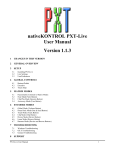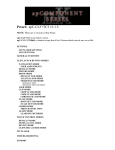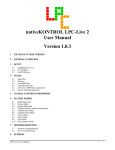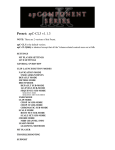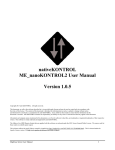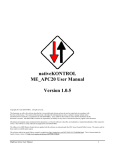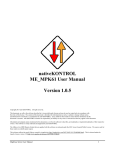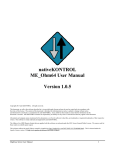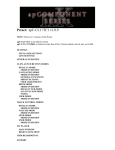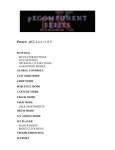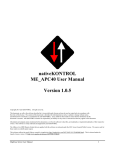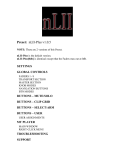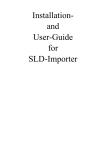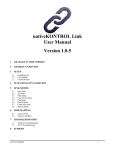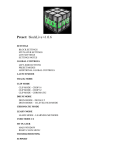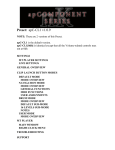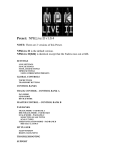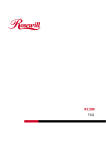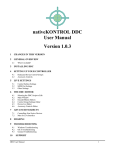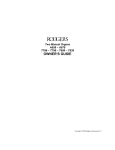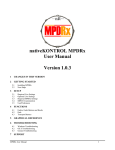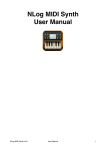Download nativeKONTROL MXT-Live User Manual
Transcript
nativeKONTROL MXT-Live User Manual Version 1.0.3 1 CHANGES IN THIS VERSION 2 GENERAL OVERVIEW 3 SETUP 3.1 3.2 Live Settings UserPreferences 4 LAYOUT OVERVIEW 5 GLOBAL CONTROLS 5.1 5.2 5.3 5.4 5.5 Upper Left Buttons Master Section Groups Section Transport Section Pads Section 6 DISPLAY (DSP) TYPES 7 PAD MODES 7.1 7.2 7.3 7.4 8 Session Mode Clip Play Mode Note Mode Navigation Mode ENCODER MODES 8.1 8.2 8.3 8.4 8.5 8.6 9 Global Mode Track Mode Clip Mode Device Mode Drum Mode MIDI Mode USING OTHER TEMPLATES AND MIDI MAPPING 9.1 9.2 10 10.1 10.2 10.3 11 General Notes Notes on Conflicts TROUBLESHOOTING General Troubleshooting Windows Troubleshooting OS X Troubleshooting SUPPORT MXT-Live User Manual 1 1 CHANGES IN THIS VERSION - Updated for compatibility with Live 9.1.3 and beyond. - Added Live 9.5.1-compatible installers. - Fixed issue where performing certain tasks (such as switching to Note Mode) could turn off Record Quantization. - Other minor fixes/improvements. NOTES: If you’ve modified your UserPreferences.txt file and don’t want to lose your changes, back up the file BEFORE installing the new version of MXT-Live. After installing, copy the text you don’t want to lose from the UserPreferences.txt file you backed up into the allotted space in the new UserPreferences.txt file that the installer will install. MXT-Live User Manual 2 2 GENERAL OVERVIEW MXT-Live is a MIDI Remote Script, Maschine MK2 template and MT Player preset for Native Instruments Maschine MK2 and Ableton Live 9 that turns the Maschine MK2 into a very powerful control surface for Live 9. In addition to this manual, a control reference (MXT-Live Control Reference.pdf) and Live Lesson are also provided. After installing MXT-Live, you can access the Live Lesson by using the following steps: 1. 2. 3. 4. Show Help View by selecting Help View from Live’s Help menu. Click the home button (rightmost button at the top of Help View) to return to the front page of Help View. Scroll down to the bottom of Help View and click the Show all built-in lessons link to show the Table of Contents. Scroll down to the bottom of the Table of Contents where you’ll find the MXT-Live Lesson section. 3 SETUP The initial installation and setup for MXT-Live is covered in the provided MXT-Live Install Info documents. Please refer to these documents for information on initial installation and setup. This section covers the settings you will need to make in Live in order to use MXT-Live and also provides information on optional settings. Please take your time when completing these steps. If you should run into trouble when performing any of these steps, please refer to the Troubleshooting section. NOTE: In order to use MXT-Live, you need to have MT Player running and the MXT-Live preset selected in MT Player. You also need to have the Maschine MK2 in MIDI Mode (accessed via SHIFT + CONTROL) and the MXT-Live template selected on the Maschine MK2. Finally, in order to see the information that MXT-Live writes to the Display, you need to select the Knob Display (via SHIFT + DISPLAY BUTTON 5). 3.1 Live Settings The following settings will be found in Live’s Preferences on the MIDI/Sync tab. All of the settings listed here are required for proper functionality of MXT-Live. 1. Under MIDI Ports, turn off all of the Track/Sync/Remote switches related to the Maschine MK2. Also, turn off all of the Track/Sync/Remote switches related to MT Player ports. 2. Select MXT_Live as a Control Surface. 3. For the Input and Output, select From MT Player 1 and To MT Player 1 respectively. On Windows, these ports may be listed with a number preceding them such as 2-From MT Player 1. 4. Under MIDI Ports, turn on the Track switches for MXT_Live Input and MXT_Live Output. 3.2 UserPreferences MXT-Live includes a UserPreferences.txt file that allows you to change some of its default behaviors and includes instructions on how to edit it. You can typically find this file in the following location: On Windows: - ProgramData\Ableton\Live 9\Resources\MIDI Remote Scripts\MXT_Live On OS X, go to Applications, find Ableton Live 9.app, right-click and select Show Package Contents and then navigate to: - Contents/App-Resources/MIDI Remote Scripts/MXT_Live MXT-Live User Manual 3 4 LAYOUT OVERVIEW The image below shows the layout of controls in MXT-Live. We’ve done our best to layout controls intuitively and to use controls that are labeled on the Maschine MK2 in ways that directly relate the control’s label. For example, in the image below you can see that the buttons labeled PLAY and DUPLICATE on the controller are also labeled PLAY and DUPLICATE in the image below. When referring to controls of this sort, we will simply refer to controls by their label such as PLAY or DUPLICATE. However, some exceptions had to be made. For example, the button labeled CONTROL on the controller is labeled as DSP TYPE in the image below. When referring to controls of this sort, we will refer to the label of the control in MXT-Live followed by the label of the control on the controller such as DSP TYPE(CONTROL). In the image below, the buttons shown in dark gray are not used by MXT-Live. The controls labeled in Blue text are modifiers, which modify the function of other controls. And the controls without labels change depending on the selected DSP Type, Pad Mode and/or Encoder Mode. MXT-Live User Manual 4 5 GLOBAL CONTROLS This section covers Global Controls, which are controls that function the same in all Modes unless otherwise noted. 5.1 Upper Left Buttons DSP TYPE(CONTROL) – When pressed quickly, toggles between the DSP Types. When held down, momentarily switches to the opposing DSP Type. When SHIFT(ENTER) is held down, pressing this button will refresh all of the controller’s LEDs and displays. This is useful in cases where you’re switching between different Maschine MK2 templates or switching between Maschine MK2’s default functionality and MIDI Mode, either of which can cause the controller’s LEDs and DISPLAY to become out of sync. Refresh will resolve this. STEP – This only applies to Pad Note Mode. ENC(BROWSE), ENC ENC(SAMPLING) and ENC CTRL(ALL) – These function differently depending on the selected Encoder Mode. AUTOMAT(AUTO WR.) – By default, toggles Automation. Holding down SHIFT(ENTER) and pressing this button will re-enable automation that has been overridden. Holding down ERASE and pressing this button will clear any recorded automation from the selected Clip. 5.2 Master Section JOG WHEEL – This controls different parameters/settings depending on which other buttons are turned on/pressed. Pressing this control will reveal the name of the parameter/setting it’s controlling as well as its current value. You can also turn the control while it is pressed. VOLUME – When turned on, the JOG WHEEL will be assigned to control Master Volume. Holding down SHIFT(ENTER) will assign the JOG WHEEL to Cue Volume. QUANTIZE(SWING) – When turned on, the JOG WHEEL will be assigned to control Global Quantization. Holding down SHIFT(ENTER) will assign the JOG WHEEL to Record Quantization. This button also serves a couple of other purposes. It functions as a modifier, which modifies the function of other controls. Also, when held down and DSP Type is set to Encoder, it sets up ENCODERS 1 – 3 to adjust Quantization settings. DISPLAY with DSP Type set to Encoder and Quantize(SWING) held down. TEMPO – When turned on, the JOG WHEEL will be assigned to control Tempo in 1-BPM increments. Holding down SHIFT(ENTER) will assign the JOG WHEEL to control Tempo in 0.1-BPM increments. UNDO(MASTER) – Triggers Live’s Undo function. MXT-Live User Manual 5 REDO(MASTER) – Triggers Live’s Redo function. REPEAT/RATE REPEAT/RATE(NOTE REPEAT) – This functions differently depending on the selected Pad Mode. Holding down SHIFT(ENTER) and pressing this button will trigger Tap Tempo. SHIFT(ENTER) – Functions as a modifier, which modifies the function of other controls. 5.3 Groups Section UP/LEFT/DOWN/RIGHT(B,E,F,G) – When Pad Session Mode is selected, these buttons use Blue LEDs (as shown) and move the grid selector in Live to select the Tracks and Scenes to control. By default, they will move the grid selector in increments of 1. When SHIFT(ENTER) is held down, they will move in increments of 4. When any Pad Mode aside from Pad Session Mode is selected, these buttons will use Green LEDs and will navigate Tracks and Scenes in Session View and the insert marker and Tracks in Arrangement View. SUSTAIN(A) – This only applies to Pad Note Mode. CLIP CTRL(C) – This button provides various control over the selected Clip. If no Clip is selected, the button’s LED will be dark. If a Clip is selected, the button’s LED will be dim White. If a Clip is selected and playing, recording or triggered in Session View, the button’s LED will be bright White. By default, this button will launch the Clip if it’s stopped or stop it otherwise. When SHIFT(ENTER) is held down, pressing this button will immediately launch or stop the Clip (without quantization). When QUANTIZE(SWING) is held down, the button’s LED will be Amber and pressing the button will quantize the Clip with the current quantization settings. When ERASE is held down, the button’s LED will be Red and pressing the button will delete the Clip. Deleting only applies to Session View. When DUPLICATE is held down, the button’s LED will be Purple and pressing the button will duplicate the Clip. Duplicating only applies to Session View. When DUPLICATE and SHIFT(ENTER) are held down, pressing the button will double the contents of the Clip. Doubling only applies to MIDI Clips. When SELECT is held down, pressing this button will lock on to the Clip (so that it continues controlling the Clip even if you navigate to another Clip) or unlock from the Clip if it’s currently locked. When locked, the button’s LED will flash White. Locking also affects all other functionality related to the selected Clip (such as Encoder Clip Mode and Pad Clip Play Mode). When MUTE is held down, the button’s LED will be Yellow and pressing the button will toggle between activating and deactivating the Clip. TRACK CTRL(H) – This button provides various control over the selected Track. If the selected Track can be armed, the button’s LED will be dim Red unless the Track is armed in which case the LED will be bright Red. If the Track cannot be armed, this button’s LED will be dark. By default, this button will toggle the Arm state of the Track if the Track can be armed. Holding down the button will fold or unfold the Track (if it is a Group Track). When SHIFT(ENTER) is held down, pressing this button will select the Clip playing on the Track. When ERASE is held down, the button’s LED will be Red and pressing the button will delete the Track. Return Tracks and the Master Track cannot be deleted. When DUPLICATE is held down, the button’s LED will be Purple and pressing the button will duplicate the Track. Return Tracks and the Master Track cannot be duplicated. MXT-Live User Manual 6 When SELECT is held down, pressing this button will lock on to the Track (so that it continues controlling the Track even if you navigate to another Track) or unlock from the Track if it’s currently locked. When locked, the button’s LED will flash White or Red if the Track is armed. Locking also affects all other functionality related to the selected Track (such as Encoder Track Mode). When SOLO is held down, the button’s LED will be Blue and pressing the button quickly will toggle the Solo state of the Track. If the button is held down, it will momentarily toggle the Solo state of the Track. When MUTE is held down, the button’s LED will be Yellow and pressing the button quickly will toggle the Mute state of the Track. If the button is held down, it will momentarily toggle the Mute state of the Track. 5.4 Transport Section RESTART – Reverts to Arrangement position 1.1.1. When SHIFT(ENTER) is held down, pressing this button will trigger Back to Arrangement. RWD(TRANSPORT)/FFW(TRANSPORT)– Rewind or fast-forward. When SHIFT(ENTER) is held down, pressing these buttons will nudge Live’s tempo down or up. FIX LEN(GRID) – Toggles Fixed Length recording. When held down, the DISPLAY will show the Fixed Length to use and this can be adjusted with the JOG WHEEL. When SHIFT(ENTER) is held down, pressing this button will select the next available Clip Slot on the selected Track for recording. This will create a new Scene if necessary. DISPLAY when FIX LEN(GRID) pressed. PLAY – Toggles playback and also functions as a visual metronome that flashes in sync with Live’s tempo. When SHIFT(ENTER) is held down, pressing this button will toggle the Metronome state. REC – In Session View, triggers Fixed Length recording (if FIX LEN(GRID) is on) or toggles Session Record/Overdub. In Arrangement View, toggles Arrangement Overdub. When SHIFT(ENTER) is held down, pressing this button will toggle Arrangement Record. ERASE – Modifies the function of other controls. MXT-Live User Manual 7 5.5 Pads Section SESSION(SCENE) – Selects Pad Session Mode. When SHIFT(ENTER) is held down, pressing this button will toggle between Session and Arrangement View. CLIP PLAY(PATTERN) – Selects Pad Clip Play Mode. When SHIFT(ENTER) is held down, pressing this button will toggle between Device and Clip View. When ERASE is held down, pressing this button will toggle between showing and hiding Detail View. NOTE(PAD MODE) – Selects Pad Note Mode. NAVIGATE NAVIGATE – Selects Pad Navigation Mode. DUPLICATE/SELECT/SOLO/MUTE – Modify the function of other controls. 6 DISPLAY (DSP) TYPES MXT-Live uses the Maschine MK2’s DISPLAY and DISPLAY BUTTONS (the 8 buttons above the DISPLAY) in two primary ways; to display information about and control settings related to the selected Encoder Mode and to display information about and control settings related to the selected Pad Mode. These two types of information display and settings control are referred to as Encoder and Pad respectively. By default, the Encoder type will be selected. When the DSP TYPE(CONTROL) button is on, the Pad type will be selected. As mentioned in the Upper Left Buttons section, pressing this button quickly will toggle between the two types. Holding the button down will momentarily switch to the opposing type. This allows you to, for example, have the Encoder type selected, momentarily switch to the Pad type to change a setting and then switch back to the Encoder type. MXT-Live User Manual 8 7 PAD MODES MXT-Live provides four primary Pad Modes; Session, Clip Play, Note and Navigation. These can be selected with SESSION(SCENE), CLIP PLAY(PATTERN), NOTE(PAD MODE) and NAVIGATE respectively. Each Pad Mode dictates the functionality of the PADS as well as REPEAT/RATE(NOTE REPEAT). Each sub-section presented here describes the functionality of the controls mentioned above for each Pad Mode. Each subsection also describes the information shown in the DISPLAY as well as the functionality of the DISPLAY BUTTONS for each Pad Mode when DSP Type is set to Pad. 7.1 Session Mode Session Mode allows you to launch Clips across 4 Tracks and 4 Scenes at a time. The Tracks and Scenes being controlled will be indicated by a grid selector (colored border). PADS – By default, the PADS are used for launching Clips. When ERASE is held down, pressing a PAD will delete the associated Clip. When DUPLICATE is held down, pressing a PAD will duplicate the associated Clip. When SELECT is held down, pressing a PAD will select the associated Clip. REPEAT/RATE REPEAT/RATE(NOTE REPEAT) – No function in this Mode. SELECT – When SHIFT(ENTER) is held down, pressing this button will unarm all Tracks. SOLO – When SHIFT(ENTER) is held down, pressing this button will unsolo all Tracks. MUTE – When SHIFT(ENTER) is held down, pressing this button will unmute all Tracks. MXT-Live User Manual 9 DISPLAY in Session Mode with DSP Type set to Pad. The upper line of the DISPLAY shows the functions available from the DISPLAY BUTTONS. By default, SCENE will launch the selected Scene. When ERASE is held down, pressing this button will delete the selected Scene. When DULICATE is held down, pressing this button will duplicate the selected Scene. STPLL will stop all Clips. By default, the last 4 DISPLAY BUTTONS (labeled STOP1 – STOP4 in the image on the previous page) will stop the Clips that are playing on the 4 Tracks being controlled. The functionality and labels of these buttons will change when certain modifiers are held down. When ERASE is held down, these buttons can be used for deleting the 4 Tracks being controlled. When DUPLICATE is held down, these buttons can be used for duplicating the 4 Tracks being controlled. When SELECT is held down, these buttons can be used for selecting the 4 Tracks being controlled. If a Track is already selected, pressing the associated button will toggle the Arm state of the Track. Holding down a button will fold or unfold the associated Track (if it is a Group Track). When SOLO is held down, these buttons can be used for soloing the 4 Tracks being controlled. If pressed quickly, they will toggle the Solo state of the associated Track. If held down, they will momentarily toggle the Solo state of the associated Track. When MUTE is held down, these buttons can be used for muting the 4 Tracks being controlled. If pressed quickly, they will toggle the Mute state of the associated Track. If held down, they will momentarily toggle the Mute state of the associated Track. The lower line of the DISPLAY shows the name of the 1st Scene and 1st Track being controlled. MXT-Live User Manual 10 7.2 Clip Play Mode Clip Play Mode allows you to play/adjust the selected Clip in several ways. This Mode is comprised of four Sub-Modes (DEF, CHOP, LOOP and CHRM) that can be selected with the DISPLAY BUTTONS when DSP Type is set to Pad. PADS when DEF is selected. PADS when CHRM is selected. PADS – When the DEF Sub-Mode is selected, the upper 8 PADS are assigned to Clip Chopping (described below) and the lower 8 PADS are assigned to Clip Loop Control (described below). When the CHOP Sub-Mode is selected, all 16 PADS are assigned to Clip Chopping. When the LOOP Sub-Mode is selected, all 16 PADS are assigned to Clip Loop Control. When the CHRM Sub-Mode is selected, all 16 PADS are assigned to Chromatic Clip Play (described below). REPEAT/RATE REPEAT/RATE(NOTE REPEAT) – When held down, assigns the first four DISPLAY BUTTONS to select the Quantization to use for launching/re-launching Clips in this Mode. This is only accessible when DSP Type is set to Pad. NOTE: The Quantization functionality will only work correctly with Clips whose Launch Quantization is set to Global. Clip Chopping Clip Chopping allows you to Chop Clips up. Each PAD used for Clip Chopping will be assigned to evenly distributed Start positions based on the Clip’s length. For Clips that are Looping, the length will be based on the Clip’s Loop Start and End Marker. For Clips that aren’t Looping, the length will be solely based on the Clip’s End Marker. Pressing a PAD used for Clip Chopping will move the Clip’s Start Marker to the corresponding position and re-launch the Clip. When ERASE is held down, pressing a PAD used for Clip Chopping will re-align the playing position of the Clip with the playing position of Live. NOTES: Clip Chopping will not work correctly with Clips whose Launch Quantization is set to None. Clip Chopping will not allow the Clip’s Start Marker to be moved to a position that is less than 1/16th note away from the Clip’s Loop End or End Marker. The process of moving a Clip’s Start Marker and re-launching is a bit more resource-dependent than just launching a Clip. For that reason, it is possible to experience hard disk overloads and/or audio drop outs when Chopping Clips. You may be able to offset this by activating the Clip’s RAM button and/or increasing the Quantization to use. Clip Loop Control Clip Loop Control allows you to select the Clip’s Loop size and position. Each PAD used for Clip Loop Control will set the Loop to the same size at evenly distributed positions based on the Clip’s length. This supports multiple PAD presses to allow for different sizes to be set. Chromatic Clip Play Chromatic Clip Play allows the PADS to play Audio or MIDI Clips chromatically. This will only work correctly on MIDI Clips if the Track the MIDI Clip is on contains a Pitch MIDI Effect that is not inside of a Rack. The PADS will control the Pitch parameter of the first Pitch MIDI Effect on the Track. MXT-Live User Manual 11 Default DISPLAY in Clip Play Mode with DSP Type set to Pad. The upper line of the DISPLAY shows the functions available from the DISPLAY BUTTONS. LOOP will toggle the Clip’s Loop on/off. When SHIFT(ENTER) is held down, pressing this button will reset the Clip’s Loop (move its Start and End to the Clip’s Start and End Markers respectively). DEF/CHOP/LOOP/CHRM select the Sub-Mode to use. When CHRM is selected, an additional function (labeled LEGAT) will be accessible. LEGAT enables/disables Legato Clip launching. When enabled, the Clip’s Launch Mode will be ignored and launching will function as if the Trigger Launch Mode was selected. The lower line of the DISPLAY shows the name of the selected Track and selected Clip. DISPLAY in Clip Play Mode with DSP Type set to Pad and REPEAT/RATE(NOTE REPEAT) held down. The functionality and information shown here is the same as noted above except that the first four DISPLAY BUTTONS (1/4 – 1/32) are used for selecting the Quantization to use for launching/re-launching Clips in this Mode MXT-Live User Manual 12 7.3 Note Mode Note Mode allows you to play, edit and sequence Notes in a variety of ways. This Mode is comprised of two Sub-Modes (Drum and Scale) that will be selected automatically depending on whether the selected Track contains a Drum Rack/Impulse device or not. This Mode also includes a Super-Mode (Sequence) accessible from either Sub-Mode that you can toggle on/off by pressing STEP. This Mode can operate on Note Lanes in the selected MIDI Clip. A Note Lane is a horizontal row of Notes in a MIDI Clip. For example, all of the C1 Notes in a MIDI Clip make up one Note Lane, all of the D#2 Notes make up another Note Lane. 7.3a Sequence Super-Mode Sequence Super-Mode allows you to step-sequence into the selected MIDI Clip. This Super-Mode can be toggled on/off by pressing STEP. This Super-Mode can be used in conjunction with the Encoder Note Edit Sub-Mode, which will allow you to easily edit Steps as they are added or selected. PADS when REPEAT/RATE(NOTE REPEAT) is off. PADS when REPEAT/RATE(NOTE REPEAT) is on. PADS – By default, the PADS will add/remove Steps in the Note Lane associated with the last PAD that was played in the Drum or Instrument Sub-Modes. The position and length of added Steps is determined by the selected Resolution (described on the next page). The velocity of added Steps is determined by the selected Velocity Type (described on the next page). When SELECT is held down, the PADS can be used for selecting Steps to edit with the Encoder Note Edit Sub-Mode. In the case of the Event Edit Sub-Mode, single Steps will be selected. In the case of the Range Edit Sub-Mode, ranges can be selected by pressing the first Step in the range and then pressing the last Step in the range. When MUTE is held down, the PADS can be used for muting/unmuting Steps or inserting muted Steps. The Steps will be added/removed/selected/muted within the selected Edit Position. When REPEAT/RATE(NOTE REPEAT) is on, the upper 8 PADS are used to select the Edit Position, which is the portion of the Clip that you will edit. This supports multiple PAD presses to allow for an Edit Position range to be selected. When SHIFT(ENTER) is held down, these PADS will select the Edit Position and Loop Position. When ERASE is held down, these PADS will delete all the Steps within the associated Edit Position or Edit Position range. The lower 8 PADS select the Loop Position, which is the portion of the Clip that will Loop. This supports multiple PAD presses to allow for a Loop Position range to be selected. In both cases, each PAD represents one sequencer page. The length of a sequencer page is determined by the selected Resolution. REPEAT/RATE REPEAT/RATE(NOTE REPEAT) – Toggles the function of the PADS between Step editing and Edit/Loop Position selection. MXT-Live User Manual 13 DISPLAY in Sequence Super-Mode with DSP Type set to Pad and REPEAT/RATE(NOTE REPEAT) off. The upper line of the DISPLAY shows the functions available from the DISPLAY BUTTONS. PAD – and PAD + will navigate between PADS to step-sequence. The rest of these buttons select the Velocity Type, which determines the velocity to use when adding Steps. INPUT will set the velocity of Steps to be equal to the velocity at which the associated PAD was pressed. RANDM will set the velocity of Steps to a random value where the highest value in the range is set by the buttons to the right (the lowest value in the range will be 27 less than the highest value). 46, 73, 100 and 127 set the velocity to a fixed value (unless RANDM is on). The lower line of the DISPLAY shows the name of the Note (or Drum Rack/Impulse Pad) being sequenced, the current Edit Position and the name of the selected Clip. DISPLAY in Sequence Super-Mode with DSP Type set to Pad and REPEAT/RATE(NOTE REPEAT) on. The information shown here is the same as noted above except that the DISPLAY BUTTONS (1/4 – 1/32T) are used for selecting the Resolution to use for sequencing. NOTE: When a triplet Resolution (such as 1/8T) is selected, the last column of PADS is not usable. The LEDs of these PADS will be dim Red to indicate this. 7.3b Functionality Common to Sub-Modes Both of the Note Mode Sub-Modes share some of the same functionality. PADS – By default, the PADS send out Notes for playing instruments/recording MIDI data into MIDI Clips. The last PAD that was played will be selected for sequencing in the Sequence Super-Mode (described in the previous section). Each PAD can also edit the Note Lane in the selected MIDI Clip associated with the Note the PAD sends. When QUANTIZE is held down, the LEDs of the PADS will either be dark (to indicate that the associated Note Lane is empty) or Amber (to indicate that the associated Note Lane is not empty). Pressing a PAD will quantize the Note Lane with the current quantization settings. When ERASE is held down, the LEDs of the PADS will either be dark (to indicate that the associated Note Lane is empty) or Red (to indicate that the associated Note Lane is not empty). Pressing a PAD will delete the associated Note Lane (if the Clip is not playing) or erase the portion of the Note Lane that the playhead is currently passing over (if the Clip is playing). When SOLO is held down, the LEDs of the PADS will either be dark (to indicate that the associated Note Lane is empty), dim Blue (to indicate that the associated Note Lane is not soloed) or bright Blue (to indicate that the associated Note Lane is soloed). Pressing a PAD will solo the associated Note Lane. MXT-Live User Manual 14 When MUTE is held down, the LEDs of the PADS will either be dark (to indicate that the associated Note Lane is empty), bright Yellow (to indicate that the associated Note Lane contains no muted Notes) or dim Yellow (to indicate that the associated Note Lane contains muted Notes). Pressing a PAD will mute the associated Note Lane. Holding down SHIFT(ENTER) and pressing MUTE will unmute all Note Lanes. REPEAT/RATE REPEAT/RATE(NOTE REPEAT) – Toggles Note Repeat on/off. When on and DSP Type is set to Pad, the DISPLAY BUTTONS can be used for selecting the Note Repeat rate. 7.3c Drum Sub-Mode Drum Sub-Mode provides a dedicated interface for playing/controlling either a Drum Rack or Impulse device on the selected Track. PADS when playing/controlling a Drum Rack. PADS when playing/controlling an Impulse device. PADS – The PADS are used for playing the visible Pads in the Drum Rack or the Impulse device on the selected Track. The PADS also provide the functionality mentioned in Functionality Common to Sub-Modes. In the case of Drum Racks, the PADS offer some additional functionality. When SELECT is held down, pressing a PAD will select the associated Drum Rack Pad. When SELECT and SOLO are held down, pressing a PAD will solo the associated Drum Rack Pad. When SHIFT(ENTER) and SELECT are held down, pressing SOLO will unsolo all Drum Rack Pads. When SELECT and MUTE are held down, pressing a PAD will mute the associated Drum Rack Pad. When SHIFT(ENTER) and SELECT are held down, pressing MUTE will unmute all Drum Rack Pads. DISPLAY in Drum Sub-Mode with DSP Type set to Pad. The upper line of the DISPLAY shows the functions available from the DISPLAY BUTTONS. DR POS – and DR POS + will move the Drum Rack’s Selector down/up, which selects the visible Pads that will be playable/controllable. By default, these will move in increments of 4 rows. When SHIFT(ENTER) is held down, they will move in increments of 1 row. FULL will toggle (if pressed quickly) or momentarily activate (if held down) Full Velocity for the PADS. The lower line of the DISPLAY shows the name of the drum device being controlled as well as the name of the selected Clip. MXT-Live User Manual 15 7.3d Scale Sub-Mode Scale Sub-Mode provides access to a variety of Scale Types as well as the ability to Capture Notes from MIDI Clips. PADS when assigned to a built-in Scale Types. PADS when assigned to Captured Notes. PADS – The PADS are used for playing the Notes of one of the built-in Scale Types or Notes that were Captured from a MIDI Clip. The PADS also provide the functionality mentioned in Functionality Common to Sub-Modes. SUSTAIN(A) – This button functions like a Sustain Pedal. This is the only part of MXT-Live that uses this button. The button’s LED will be purple when Scale Sub-Mode is selected. DISPLAY in Scale Sub-Mode with DSP Type set to Pad. The upper line of the DISPLAY shows the functions available from the DISPLAY BUTTONS. OCT – and OCT + will scroll down/up by 1 Octave. When SHIFT(ENTER) is held down, OCT – and OCT + will scroll down/up by 1 Semitone. ROOT – and ROOT + will move down/up between Root Notes. These buttons will not be accessible when the PADS are assigned to Captured Notes. TYPE – and TYPE + will move down/up between Scale Types. CAP will capture the first 16 unique Notes from the selected MIDI Clip and assign them to the PADS in Note order. If more than 16 unique Notes have been captured, you can scroll between them by holding down SHIFT(ENTER) and using OCT – and OCT +. FULL will toggle (if pressed quickly) or momentarily activate (if held down) Full Velocity for the PADS. The lower line of the DISPLAY shows the name of the current Root Note and Scale Type as well as the name of the selected Clip. If the PADS are assigned to Captured Notes, the name of the Clip the Notes were Captured from will be displayed instead of the Root Note and Scale Type. Also, upon changing any of the settings mentioned above, the Note range of the PADS will momentarily be shown in the DISPLAY. MXT-Live User Manual 16 7.4 Navigation Mode Navigation Mode allows for sending keystrokes/shortcuts as well as triggering ClyphX Action Lists. PADS – The PADS send the keystrokes/shortcuts shown above. These are self-explanatory except for PAD 13 – PAD 15. These PADS are used to move the Focus to different sections of Live’s window (the Browser section, the Main section of the window and the Detail View section) so that the section can be controlled via keystrokes/shortcuts. REPEAT/RATE REPEAT/RATE(NOTE REPEAT) – No function in this Mode. DISPLAY in Navigation Mode with DSP Type set to Pad and Key Assignments selected. DISPLAY in Navigation Mode with DSP Type set to Pad and ClyphX Assignments selected. The DISPLAY BUTTONS can send keystrokes/shortcuts or trigger ClyphX Action Lists. You can toggle between these sets of functions by pressing NAVIGATE. In both cases, the upper line of the DISPLAY shows the names of the keystrokes/shortcuts or ClyphX Action Lists assigned to the DISPLAY BUTTONS. If a button has no keystroke/shortcut assignment or ClyphX Action List assignment, the button’s LED will be dark and the associated section of the DISPLAY will be blank. You can specify the keystrokes/shortcuts to send and ClyphX Action Lists to trigger in your UserPreferences file. NOTE: In order to trigger ClyphX Action Lists in this Mode, ClyphX needs to be installed and selected as a Control Surface. You can download and learn more about ClyphX here: http://beatwise.proboards.com/board/5/clyphx MXT-Live User Manual 17 8 ENCODER MODES MXT-Live provides six primary Encoder Modes; Global, Track, Clip, Device, Drum and MIDI. These can be selected when DSP Type is set to Encoder by holding down SELECT and using the first six DISPLAY BUTTONS. DISPLAY with DSP Type set to Encoder and SELECT held down. Each Encoder Mode dictates the functionality of the ENCODERS as well as ENC(BROWSE), ENC(SAMPLING) and ENC CTRL(ALL). Each sub-section presented here describes the functionality of the controls mentioned above for each Encoder Mode. Each sub-section also describes the functionality of the DISPLAY BUTTONS for each Encoder Mode when DSP Type is set to Encoder. Additional Parameter Control Encoder Modes that control device or mixer parameters (Track, Device and Drum in particular) utilize the DISPLAY BUTTONS for additional parameter control. By default, the DISPLAY BUTTONS allow for proper automation recording. When pressed, Live is informed to start recording automation for the parameter assigned to the associated ENCODER. When released, Live is informed to stop recording automation from the parameter assigned to the associated ENCODER. This allows automation to be recorded without overwriting existing automation. When SHIFT(ENTER) is held down, the DISPLAY BUTTONS reset or toggle the value of the parameter assigned to the associated ENCODER. The button LEDs will be lit if resetting or toggling is possible. When ERASE is held down, the DISPLAY BUTTONS clear automation that has been recorded for the parameter assigned to the associated ENCODER. If you’re using Live 9.1 or later, the button LEDs will be lit if clearing automation is possible. Otherwise, the buttons LEDs will be dark. MXT-Live User Manual 18 8.1 Global Mode Global Mode controls global settings. ENCODER 1 – Rewinds/fast-forwards by 1 Beat or 1 Bar if SHIFT(ENTER) is held down. ENCODER 2 – Navigates between Arrangement Locators. When SHIFT(ENTER) is held down, turning ENCODER 2 will add a Locator at the current position or delete the Locator at the current position if one exists. ENCODER 3 and ENCODER 4 – Adjust Arrangement Loop Start and Length by 1 Beat or 1 Bar if SHIFT(ENTER) is held down. ENCODER ENCODER 5 – Turns Arrangement Loop on/off. ENCODER 6 – Zooms horizontally in Arrangement View or navigates Tracks in Session View. ENCODER 7 – Zooms the selected Track vertically in Arrangement View or navigates Scenes in Session View. When SHIFT(ENTER) is held down, turning ENCODER 7 will vertically zoom all Tracks in Arrangement View. ENCODER 8 – Adjusts Global Groove Amount. ENC(BROWSE) and ENC ENC(SAMPLING) – Toggle Punch In and Out respectively. ENC CTRL(ALL) – No function in this Mode. DISPLAY in Global Mode with DSP Type set to Encoder. DISPLAY BUTTONS – No function in this Mode. MXT-Live User Manual 19 8.2 Track Mode Track Mode controls parameters/settings of the selected Track. This Mode is comprised of two Sub-Modes (Default and I/O) that can be selected with the ENC(BROWSE) and ENC(SAMPLING) respectively. ENC(BROWSE) and ENC ENC(SAMPLING) – Select the Default and I/O Sub-Modes respectively. ENC CTRL(ALL) – No function in this Mode. 8.2a Default Sub-Mode In the Default Sub-Mode, the ENCODERS provide control over the Track’s Volume, Pan and its first 5 Sends. By default, the ENCODERS offer relatively coarse adjustment. When SHIFT(ENTER) is held down, the ENCODERS offer finer adjustment. DISPLAY in Default Sub-Mode with DSP Type set to Encoder. DISPLAY DISPLAY BUTTONS – Provide Additional Parameter Control. 8.2b I/O Sub-Mode In the I/O Sub-Mode, the ENCODERS provide control over the Track’s Input Routing, Input Sub-Routing, Output Routing, Output Sub-Routing, Monitoring State and Crossfade Assignment. DISPLAY in I/O Sub-Mode with DSP Type set to Encoder. DISPLAY BUTTONS – No function in this Sub-Mode. MXT-Live User Manual 20 8.3 Clip Mode Clip Mode controls settings of the selected Clip. This Mode is comprised of two Sub-Modes (Default and Note Edit) that can be selected with the ENC(BROWSE) and ENC(SAMPLING) respectively. ENC(BROWSE) and ENC ENC(SAMPLING) – Select the Default and Note Edit Sub-Modes respectively. 8.3a Default Sub-Mode In the Default Sub-Mode, the ENCODERS provide control over the Clip’s Start/End Markers, Loop Start/End, Detune, Transpose and Gain. By default, the ENCODERS offer relatively fine adjustment. When SHIFT(ENTER) is held down, the ENCODERS offer coarser adjustment. Adjustments of Start/End Markers and Loop Start/End are quantized. The quantization to use can be selected via ENCODER 8. ENC CTRL(ALL) – No function in this Sub-Mode. DISPLAY in Default Sub-Mode with DSP Type set to Encoder. DISPLAY BUTTONS – No function in this Sub-Mode. NOTES: Detune, Transpose and Gain are only accessible to Audio Clips. Loop Start/End are only accessible for Clips that are looping. Start Marker and Loop Start cannot be moved to a position less than 1.1.1. Loop End cannot be moved to a position greater than the Clip’s End Marker. 8.3b Note Edit Sub-Mode In the Note Edit Sub-Mode, the ENCODERS provide edit control over Note Events in MIDI Clips. By default, the ENCODERS offer relatively fine adjustment. When SHIFT(ENTER) is held down, the ENCODERS offer coarser adjustment. There are two Note Edit Sub-Modes (Event and Range) that you can toggle between by pressing ENC(SAMPLING). NOTES: Pitch, Time and Length will not allow you to move Note Events to an occupied or partially occupied position/pitch. Time and Length will not allow you to adjust Note Events such that they would extend past the Clip’s End. Time will not allow you to move Note Events to a position less than 1.1.1. The Note Edit Sub-Modes will select Notes in the MIDI Clip upon changes. However, some changes to a MIDI Clip can cause the selection in the MIDI Clip to become out of sync with the selection(s) in the Note Edit Sub-Modes. This can be rectified by pressing ENC(SAMPLING) twice. 8.3b1 Event Edit Sub-Mode The Event Edit Sub-Mode allows you to edit one Note Event at a time. ENCODER 1 – Selects the Note Event to edit. ENCODER 2 – Adjusts the Pitch of the Note Event. ENCODER 3 and ENCODER 4 – Adjust the Time and Length of the Note Event. These adjustments are quantized. The quantization to use can be selected via ENCODER 8. MXT-Live User Manual 21 ENCODER 5 – Adjusts the Velocity of the Note Event. ENCODER 6 – Adjusts the Muted status of the Note Event. ENCODER 7 – Selects the type of sorting to use (TIME or PITCH) to use when selecting Note Events with ENCODER 1. ENCODER 8 – Selects the quantization to use when adjusting Note Event Time and Length. ENC CTRL(ALL) – When SHIFT(ENTER) is held down, pressing this button will add a new Note Event. This will be added after the selected Note Event if possible or will be added at the next Pitch up. When adding Note Events, it’s possible that portions of existing Note Events will be overwritten. When ERASE is held down, pressing this button will delete the selected Note Event. DISPLAY in Event Edit Sub-Mode with DSP Type set to Encoder. DISPLAY BUTTONS – No function in this Sub-Mode. 8.3b2 Range Edit Sub-Mode The Range Edit Sub-Mode allows you edit ranges of Note Events. ENCODER 1 and ENCODER 2 – Select the range of Note Event Pitches to edit. ENCODER 3 and ENCODER 4 – Select the range of Note Event Times to edit. ENCODER 6 – Selects the Note Event setting that ENCODER 7 will adjust. ENCODER 7 – Adjusts the selected Note Event setting. Adjustments of Time and Length are quantized. The quantization to use can be selected via ENCODER 8. ENCODER 8 – Selects the quantization to use when adjusting Note Event Time and Length. ENC CTRL(ALL) – When SHIFT(ENTER) is held down, pressing this button will select all Note Events. When ERASE is held down, pressing this button will delete Note Events within the selected range. DISPLAY in Range Edit Sub-Mode with DSP Type set to Encoder. DISPLAY BUTTONS – No function in this Sub-Mode. MXT-Live User Manual 22 8.4 Device Mode In Device Mode, the ENCODERS control parameters of the selected Device. By default, the ENCODERS offer relatively coarse adjustment. When SHIFT(ENTER) is held down, the ENCODERS offer finer adjustment. ENC(BROWSE) and ENC ENC(SAMPLING) – If the selected Device has more than 8 parameters, these will move between banks of 8 parameters. If the selected Device is a Rack with Chains, these will move between the Device’s Chains. When SHIFT(ENTER) is held down, these will navigate between Devices on the selected Track. ENC CTRL(ALL) – Toggles the selected Device on/off. When SHIFT(ENTER) is held down, pressing this button will lock to/unlock from the selected Device. When locked, the button’s LED will flash. When ERASE is held down, pressing this button will delete the selected Device. DISPLAY in Device Mode with DSP Type set to Encoder. DISPLAY BUTTONS – Provide Additional Parameter Control. 8.5 Drum Mode In Drum Rack Mode, ENCODERS 1-7 control mixer settings (Volume, Pan and the first 5 Sends) of the selected Drum Rack Pad of the Drum Rack on the selected Track. By default, ENCODERS 1-7 offer relatively coarse adjustment. When SHIFT(ENTER) is held down, ENCODERS 1-7 offer finer adjustment. ENCODER 8 scrolls between Drum Rack Pads by 1 or by 16 when SHIFT(ENTER) is held down. If necessary, this will also move the Drum Rack Selector so that the selected Drum Rack Pad is visible. ENC(BROWSE) – Toggles the selected Drum Rack Pad’s Mute switch if pressed quickly or momentarily toggles the Mute switch if held down. When SHIFT(ENTER) is held down, pressing this button will unmute all Drum Rack Pads. ENC ENC(SAMPLING) – Toggles the selected Drum Rack Pad’s Solo switch if pressed quickly or momentarily toggles the Solo switch if held down. When SHIFT(ENTER) is held down, pressing this button will unsolo all Drum Rack Pads. ENC CTRL(ALL) – When ERASE is held down, pressing this button will delete the Drum Rack. DISPLAY in Drum Mode with DSP Type set to Encoder. DISPLAY BUTTONS – Provide Additional Parameter Control. MXT-Live User Manual 23 8.6 MIDI Mode MIDI Mode sends out common MIDI Control Change messages (CCs) and Program Change messages, which most MIDI instruments respond to. By default, the ENCODERS offer coarse adjustment. When SHIFT(ENTER) is held down, the ENCODERS offer finer adjustment. ENCODER 1 – Sends out Volume (CC#7). ENCODER 2 – Sends out Pan (CC#10). ENCODER 3 – Sends out Filter Cutoff (CC#74). ENCODER 4 – Sends out Filter Resonance (CC#71). ENCODER 5 – Sends out Amp Envelope Attack (CC#73). ENCODER 6 and ENCODER 7 – Send out Bank Select messages (CC#0 and CC#32). Turning either of these ENCODERS will send out both the MSB and LSB value and will also send out a Program Change message with a value of 0. This is done as most MIDI instruments require this sequence of messages in order to actually switch between banks. ENCODER 8 – Sends out Program Change messages. ENC(BROWSE) and ENC ENC(SAMPLING) – Send out Program Change messages incrementally. ENC CTRL(ALL) – No function in this Mode. DISPLAY in MIDI Mode with DSP Type set to Encoder. DISPLAY BUTTONS – No function in this Mode. MXT-Live User Manual 24 9 USING OTHER TEMPLATES AND MIDI MAPPING When using the default Live settings for MXT-Live, it is not possible for other controllers/MIDI devices or other Maschine MK2 templates to conflict with MXT-Live as MXT-Live has a direct line of communication with Live. However, the default settings also prevent you from using other Maschine MK2 templates for MIDI mapping. It is possible to use other Maschine MK2 templates for MIDI mapping while using MXT-Live, but this adds a bit of complexity and the potential for problems due to the way Live’s MIDI mapping functionality works. In some cases though, MIDI mapping is essential and so dealing with the problems it raises are worth it. To allow for MIDI mapping, you will need to turn on the Remote switches for MXT-Live Input and Output. 9.1 General Notes - You should not use MIDI mapping to map controls in the MXT-Live template. You should only map controls in other Maschine MK2 templates. - Other Maschine MK2 templates should not use the same MIDI messages that are used by the MXT-Live template. You can see these messages by looking at the MXT-Live template with the Native Instruments Controller Editor. To summarize though, the MXT-Live template uses Note numbers 0 – 60 on MIDI channel 16 and CC numbers 16 – 23 and 60 on MIDI channel 1. 9.2 Notes on Conflicts Once you’ve turned on the Remote switches for MXT-Live Input and Output, this will open up the potential for conflicts with other controllers/MIDI devices whose Remote switches are turned on. Review the following notes for help with avoiding these conflicts. - Other controllers/MIDI devices should not use the same MIDI messages that are used by the MXT-Live template (as described in the previous section). - Other controllers/MIDI devices should not use the same MIDI messages that you’re using in other Maschine MK2 templates that you’re using for MIDI mapping. MXT-Live User Manual 25 10 TROUBLESHOOTING This section provides resolutions to common problems that you may run into when installing or using MXT-Live. If you do not find a resolution to your problem here, please contact Support. 10.1 General Troubleshooting I’m sure that my Live settings are correct, but MXT-Live does not work. First, please double-check your Live settings against those provided. If you’re sure that these are correct, then it’s likely you’ve made some incorrect settings in MT Player. To resolve this, you can reset MT Player. Please note, however, that this will clear out any settings you’ve made in MT Player. To reset MT Player: 1. Close MT Player. 2. Go to: o o My Documents\Bome’s Midi Translator\Player (Windows) (your name)/Bome’s Midi Translator/Player (OS X) 3. Launch the app named MT Control Panel and click RESET. 4. Relaunch MT Player. 5. Upon relaunching MT Player, select the MXT-Live Preset if it isn’t already selected. 6. You may be prompted to select MIDI ports to use. If so, you should select Maschine MK2’s ports (or Virtual ports on OS X) at these prompts. 10.2 Windows Troubleshooting I’ve ran the provided Setup executable, but don’t find MXT_Live listed under Control Surfaces. If Live was running at the time you ran the Setup executable, you will need to restart Live. If this doesn’t resolve the problem, then it’s likely that you’ve installed Live in a protected location (such as Program Files). In this case, you will need to elevate the permissions on your Live installation directory so that you can write to it. Once this is done, re-run the Setup executable. Upon launching MT Player I receive an error message regarding Maschine MK2’s ports. Please close Live, MT Player and any other MIDI applications. Then re-launch MT Player. 10.3 OS X Troubleshooting I’ve ran the provided Setup package, but don’t find MXT_Live listed under Control Surfaces. If Live was running at the time you ran the Setup application, you will need to restart Live. MXT-Live User Manual 26 11 SUPPORT Email: [email protected] Forum: Beatwise Network Copyright 2013-2015 nativeKONTROL. All rights reserved. This document, as well as the software described in it, is provided under license and may be used or copied only in accordance with the terms of this license. The content of this document is furnished for informational use only, is subject to change without notice, and should not be construed as a commitment by nativeKONTROL. Every effort has been made to ensure that the information in this document is accurate. nativeKONTROL assumes no responsibility or liability for any errors or inaccuracies that may appear in this document. All product and company names mentioned in this document, as well as the software it describes, are trademarks or registered trademarks of their respective owners. This software is solely endorsed and supported by nativeKONTROL. The Ableton Live MIDI Remote Scripts that are supplied with the software are released under the GNU Lesser General Public License. The source code for these scripts is available upon request. MXT-Live User Manual 27



























